Portal:Germany/Selected article
These are subpages that can be transcluded from the main portal. If you add a new one, don't forget to update the maximum in the source code of Portal:Germany so that it corresponds to the largest bluelinked number below. If you make any changes (or if the quality of any of the articles changes), please also update the table at Portal:Germany/Selected articles and pictures.
Selected article 1
Portal:Germany/Selected article/1

Ludwigsburg Palace, nicknamed the "Versailles of Swabia", is a 452-room palace complex of 18 buildings located in Ludwigsburg, Baden-Württemberg, Germany. Its total area, including the gardens, is 32 ha (79 acres) – the largest palatial estate in the country. The palace has four wings: the northern wing, the Alter Hauptbau, is the oldest and was used as a ducal residence; the east and west wings were used for court purposes and housing guests and courtiers; the southern wing, the Neuer Hauptbau, was built to house more court functions and was later used as a residence.
Eberhard Louis, Duke of Württemberg, appointed Philipp Joseph Jenisch to direct the work and construction began in 1704. In 1707, Jenisch was replaced with Johann Friedrich Nette, who completed the majority of the palace and surrounding gardens. Nette died in 1714, and Donato Giuseppe Frisoni finished much of the palace façades. In the final year of construction, Eberhard Louis died and the Neue Hauptbau's interiors were left incomplete. Charles Eugene's court architect, Philippe de La Guêpière, completed and refurbished parts of the New Hauptbau in the Rococo style, especially the palace theatre. Charles Eugene abandoned the palace for Stuttgart in 1775. Duke Frederick II, later King Frederick I, began using Ludwigsburg as his summer residence in the last years of Charles Eugene's reign. Frederick and his wife Charlotte, Princess Royal, resided at Ludwigsburg and employed Nikolaus Friedrich von Thouret to renovate the palace in the Neoclassical style. Thouret converted much of Ludwigsburg's interiors over the reign of Frederick and later life of Charlotte. As a result of each architect's work, Ludwigsburg is a combination of Baroque, Rococo, Neoclassical, and Empire style architecture. (Full article...)
Selected article 2
Portal:Germany/Selected article/2
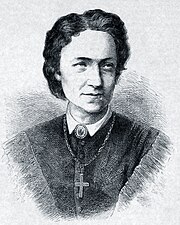
Adelheid Luise "Adele" Spitzeder ([ˈaːdl̩haɪt ʔaˈdeːlə ˈʃpɪtˌtseːdɐ]; 9 February 1832 – 27 or 28 October 1895), also known by her stage name Adele Vio, was a German actress, folk singer, and con artist. Initially a promising young actress, Spitzeder became a well-known private banker in 19th-century Munich when her theatrical success dwindled. Running what was possibly the first recorded Ponzi scheme, she offered large returns on investments by continually using the money of new investors to pay back the previous ones. At the height of her success, contemporary sources considered her the wealthiest woman in Bavaria.
Opening her bank in 1869, Spitzeder managed to fend off attempts to discredit her for a few years before authorities were able to bring her to trial in 1872. Because Ponzi schemes were not yet illegal, she was convicted instead of bad accounting and mishandling customers' money and sentenced to three years in prison. Her bank was closed and 32,000 people lost 38 million gulden, the equivalent of almost 400 million euros in 2017 money, causing a wave of suicides. Her personal fortune in art and cash was stripped from her. (Full article...)
Selected article 3
Portal:Germany/Selected article/3

Riesling is a white grape variety which originates in the Rhine region of Germany. Riesling is an aromatic grape variety displaying flowery, almost perfumed, aromas as well as high acidity. It is used to make dry, semi-sweet, sweet and sparkling white wines. Riesling wines are usually varietally pure and are seldom oaked. As of 2004, Riesling was estimated to be the world's 20th most grown variety at 48,700 hectares (120,000 acres) (with an increasing trend), but in terms of importance for quality wines, it is usually included in the "top three" white wine varieties together with Chardonnay and Sauvignon Blanc. Riesling is a variety which is highly "terroir-expressive", meaning that the character of Riesling wines is clearly influenced by the wine's place of origin.
In 2006, Riesling was the most grown variety in Germany with 20.8% and 21,197 hectares (52,380 acres), and in the French region of Alsace with 21.9% and 3,350 hectares (8,300 acres). There are also significant plantings of Riesling in Austria, Luxembourg, northern Italy, Australia, New Zealand, United States, Canada, South Africa, China and Ukraine. In the countries where it is cultivated, Riesling is most commonly grown in colder regions and locations. More ...
Selected article 4
Portal:Germany/Selected article/4
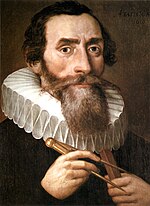
Johannes Kepler (/ˈkɛplər/; German: [joˈhanəs ˈkɛplɐ, -nɛs -] ⓘ; 27 December 1571 – 15 November 1630) was a German astronomer, mathematician, astrologer, natural philosopher and writer on music. He is a key figure in the 17th-century Scientific Revolution, best known for his laws of planetary motion, and his books Astronomia nova, Harmonice Mundi, and Epitome Astronomiae Copernicanae, influencing among others Isaac Newton, providing one of the foundations for his theory of universal gravitation. The variety and impact of his work made Kepler one of the founders and fathers of modern astronomy, the scientific method, natural and modern science. He has been described as the "father of science fiction" for his novel Somnium.
Kepler was a mathematics teacher at a seminary school in Graz, where he became an associate of Prince Hans Ulrich von Eggenberg. Later he became an assistant to the astronomer Tycho Brahe in Prague, and eventually the imperial mathematician to Emperor Rudolf II and his two successors Matthias and Ferdinand II. He also taught mathematics in Linz, and was an adviser to General Wallenstein. Additionally, he did fundamental work in the field of optics, being named the father of modern optics, in particular for his Astronomiae pars optica. He also invented an improved version of the refracting telescope, the Keplerian telescope, which became the foundation of the modern refracting telescope, while also improving on the telescope design by Galileo Galilei, who mentioned Kepler's discoveries in his work. (Full article...)
Selected article 5
Portal:Germany/Selected article/5
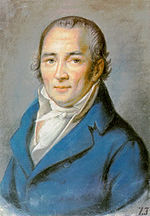
Johann Peter Hebel (10 May 1760 – 22 September 1826) was a German short story writer, dialectal poet, Lutheran theologian and pedagogue, most famous for a collection of Alemannic lyric poems (Allemannische Gedichte) and one of German tales (Schatzkästlein des rheinischen Hausfreundes – "Treasure Chest of Rhenish Tales").
Born in Basel, Hebel entered primary school in 1766 and joined a Latin school three years later; he visited the schools in Basel during summer and in Hausen and Schopfheim respectively in the nearby Wiesental during winter. After the death of his mother in 1773, he remained at school, graduating with the help of friends from the Gymnasium illustre of Karlsruhe in 1778 and going on to study theology. He became a home tutor, an assistant preacher, an assistant teacher, a subdeacon and, in 1798, a professor and court deacon.
Hebel was interested in botany, natural history and other subjects. His literary work began with Allemannische Gedichte, which is perhaps the most popular work written in Alemannic. He had success with his calendar stories in the Badischer Landkalender, and later with Rheinländischer Hausfreund (Rhenish Family Treasury), but a dispute between Catholics forced him to resign as editor of the calendar. In his last years he devoted himself increasingly to religion, becoming a prelate in 1819, but his wish to become a parish priest was never fulfilled. His last works were biblical stories for young readers, which served as textbooks until 1855. Hebel died 1826 in Schwetzingen. Goethe, Tolstoy, Gottfried Keller, Hermann Hesse, Martin Heidegger and other writers have praised his works. (Full article...)
Selected article 6
Portal:Germany/Selected article/6

Albert Einstein (March 14, 1879 – April 18, 1955) was a theoretical physicist widely regarded as the most important scientist of the 20th century. He developed the special and general theories of relativity and made significant contributions to quantum mechanics, statistical mechanics, and cosmology. He was awarded the 1921 Nobel Prize for Physics for his explanation of the photoelectric effect in 1905 (his "wonderful year") and "for his services to Theoretical Physics".
After British solar eclipse expeditions in 1919 confirmed that light rays from distant stars were deflected by the gravity of the Sun in the amount he had predicted in his theory of relativity, Einstein became world-famous, an unusual achievement for a scientist. In his later years, his fame perhaps exceeded that of any other scientist in history. In popular culture, his name has become synonymous with great intelligence and genius. More...
Selected article 7
Portal:Germany/Selected article/7
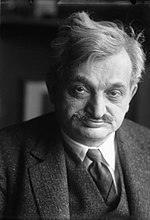
Emanuel Lasker (German pronunciation: [eˈmaːnuɛl ˈlaskɐ] ⓘ; December 24, 1868 – January 11, 1941) was a German chess player, mathematician, and philosopher. He was the second World Chess Champion, holding the title for 27 years, from 1894 to 1921, the longest reign of any officially recognised World Chess Champion in history. In his prime, Lasker was one of the most dominant champions, and he is still generally regarded as one of the strongest players in history.
His contemporaries used to say that Lasker used a "psychological" approach to the game, and even that he sometimes deliberately played inferior moves to confuse opponents. Recent analysis, however, indicates that he was ahead of his time and used a more flexible approach than his contemporaries, which mystified many of them. Lasker knew contemporary analyses of openings well but disagreed with many of them. He published chess magazines and five chess books, but later players and commentators found it difficult to draw lessons from his methods.
Lasker made contributions to the development of other games. He was a first-class contract bridge player and wrote about bridge, Go, and his own invention, Lasca. His books about games presented a problem that is still considered notable in the mathematical analysis of card games. Lasker was a research mathematician who was known for his contributions to commutative algebra, which included proving the primary decomposition of the ideals of polynomial rings. His philosophical works and a drama that he co-wrote, however, received little attention. (Full article...)
Selected article 8
Portal:Germany/Selected article/8

Johann George Adam Forster, also known as Georg Forster (German pronunciation: [ˈɡeːɔʁk ˈfɔʁstɐ], 27 November 1754 – 10 January 1794), was a German geographer, naturalist, ethnologist, travel writer, journalist and revolutionary. At an early age, he accompanied his father, Johann Reinhold Forster, on several scientific expeditions, including James Cook's second voyage to the Pacific. His report of that journey, A Voyage Round the World, contributed significantly to the ethnology of the people of Polynesia and remains a respected work. As a result of the report, Forster, who was admitted to the Royal Society at the early age of twenty-two, came to be considered one of the founders of modern scientific travel literature.
After returning to continental Europe, Forster turned toward academia. He taught natural history at the Collegium Carolinum in the Ottoneum, Kassel (1778–84), and later at the Academy of Vilna (Vilnius University) (1784–87). In 1788, he became head librarian at the University of Mainz. Most of his scientific work during this time consisted of essays on botany and ethnology, but he also prefaced and translated many books about travel and exploration, including a German translation of Cook's diaries.
Forster was a central figure of the Enlightenment in Germany, and corresponded with most of its adherents, including his close friend Georg Christoph Lichtenberg. His ideas, travelogues and personality influenced Alexander von Humboldt, one of the great scientists of the 19th century who hailed Forster as the founder of both comparative ethnology (Völkerkunde) and regional geography (Länderkunde). When the French took control of Mainz in 1792, Forster played a leading role in the Mainz Republic, the earliest republican state in Germany. During July 1793 and while he was in Paris as a delegate of the young Mainz Republic, Prussian and Austrian coalition forces regained control of the city and Forster was declared an outlaw. Unable to return to Germany and separated from his friends and family, he died in Paris of illness in early 1794, not yet 40. (Full article...)
Selected article 9
Portal:Germany/Selected article/9
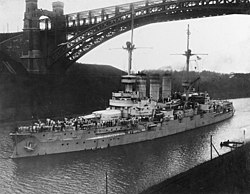
SMS Lothringen was the last of five pre-dreadnought battleships of the Braunschweig class, built for the German Kaiserliche Marine (Imperial Navy). She was laid down in December 1902, was launched in May 1904, and was commissioned in May 1906. She was named for the then-German province of Lothringen (now Lorraine). The ship was armed with a battery of four 28 cm (11 in) guns and had a top speed of 18 knots (33 km/h; 21 mph). Like all other pre-dreadnoughts built around the turn of the century, Lothringen was quickly made obsolete by the launching of the revolutionary HMS Dreadnought in 1906; as a result, her career as a front-line battleship was cut short.
Lothringen's peacetime career centered on squadron and fleet exercises and training cruises with II Battle Squadron. Scheduled to be withdrawn from service in July 1914 and replaced by newer dreadnought battleships, the outbreak of World War I that month prevented her retirement. She spent the first two years of the war primarily serving as a guard ship in the German Bight. She and the rest of II Squadron joined the dreadnoughts of the High Seas Fleet to support the raid on Scarborough, Hartlepool, and Whitby in December 1914. In poor condition by 1916, she was withdrawn from fleet service in February. She thereafter patrolled the Danish straits until she was replaced by the battleship Hannover in September 1917. She spent the rest of the war as a disarmed training ship.
After the war, Lothringen was retained by the re-formed Reichsmarine and converted into a depot ship for F-type minesweepers from 1919 to 1920. After the task of clearing the wartime minefields in the North Sea was completed, she was placed in reserve in March 1920. The ship remained inactive for the next decade and was stricken from the naval register in March 1931 and sold to ship breakers later that year. (Full article...)
Selected article 10
Portal:Germany/Selected article/10
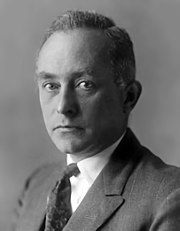
Max Born FRS, FRSE (German pronunciation: [ˈmaks ˈbɔʁn] ⓘ; 11 December 1882 – 5 January 1970) was a German-British physicist and mathematician who was instrumental in the development of quantum mechanics. He also made contributions to solid-state physics and optics and supervised the work of a number of notable physicists in the 1920s and 1930s. Born was awarded the 1954 Nobel Prize in Physics for his "fundamental research in quantum mechanics, especially in the statistical interpretation of the wave function".
Born entered the University of Göttingen in 1904, where he met the three renowned mathematicians Felix Klein, David Hilbert, and Hermann Minkowski. He wrote his PhD thesis on the subject of "Stability of Elastica in a Plane and Space", winning the university's Philosophy Faculty Prize. In 1905, he began researching special relativity with Minkowski, and subsequently wrote his habilitation thesis on the Thomson model of the atom. A chance meeting with Fritz Haber in Berlin in 1918 led to discussion of how an ionic compound is formed when a metal reacts with a halogen, which is today known as the Born–Haber cycle.
In World War I he was originally placed as a radio operator, but his specialist knowledge led to his being moved to research duties on sound ranging. In 1921 Born returned to Göttingen, where he arranged another chair for his long-time friend and colleague James Franck. Under Born, Göttingen became one of the world's foremost centres for physics. In 1925 Born and Werner Heisenberg formulated the matrix mechanics representation of quantum mechanics. The following year, he formulated the now-standard interpretation of the probability density function for ψ*ψ in the Schrödinger equation, for which he was awarded the Nobel Prize in 1954. His influence extended far beyond his own research. Max Delbrück, Siegfried Flügge, Friedrich Hund, Pascual Jordan, Maria Goeppert-Mayer, Lothar Wolfgang Nordheim, Robert Oppenheimer, and Victor Weisskopf all received their PhD degrees under Born at Göttingen, and his assistants included Enrico Fermi, Werner Heisenberg, Gerhard Herzberg, Friedrich Hund, Wolfgang Pauli, Léon Rosenfeld, Edward Teller, and Eugene Wigner.
In January 1933, the Nazi Party came to power in Germany, and Born, who was Jewish, was suspended from his professorship at the University of Göttingen. He emigrated to the United Kingdom, where he took a job at St John's College, Cambridge, and wrote a popular science book, The Restless Universe, as well as Atomic Physics, which soon became a standard textbook. In October 1936, he became the Tait Professor of Natural Philosophy at the University of Edinburgh, where, working with German-born assistants E. Walter Kellermann and Klaus Fuchs, he continued his research into physics. Born became a naturalised British subject on 31 August 1939, one day before World War II broke out in Europe. He remained in Edinburgh until 1952. He retired to Bad Pyrmont, in West Germany, and died in a hospital in Göttingen on 5 January 1970. (Full article...)
Selected article 11
Portal:Germany/Selected article/11

Max Weber (April 21, 1864 – June 14, 1920) was a German political economist and sociologist who is considered one of the founders of the modern study of sociology and public administration. He began his career at the University of Berlin, and later worked at Freiburg University, University of Heidelberg, University of Vienna and University of Munich. He was influential in contemporary German politics, being one of Germany's negotiators at the Treaty of Versailles and the member of the commission charged with drafting the Weimar Constitution.
His major works deal with rationalisation in sociology of religion and government, but he also contributed much in the field of economics. His most famous work is his essay The Protestant Ethic and the Spirit of Capitalism, which began his work in the sociology of religion. More...
Selected article 12
Portal:Germany/Selected article/12

The IG Farben Building – also known as the Poelzig Building and the Abrams Building, formerly informally called The Pentagon of Europe – is a building complex in Frankfurt, Germany, which currently serves as the main structure of the Westend Campus of the University of Frankfurt. Construction began in 1928 and was complete in 1930 as the corporate headquarters of the IG Farben conglomerate, then the world's largest chemical company and the world's fourth-largest company overall.
The building's original design in the modernist New Objectivity style was the subject of a competition which was eventually won by the architect Hans Poelzig. On its completion, the complex was the largest office building in Europe and remained so until the 1950s. The IG Farben Building's six square wings retain a modern, spare elegance, despite its mammoth size. It is also notable for its paternoster elevators.
The building was the headquarters for production administration of dyes, pharmaceutical drugs, magnesium, lubricating oil, explosives, and methanol, and for research projects relating to the development of synthetic oil and rubber during World War II. Notably IG Farben scientists discovered the first antibiotic, fundamentally reformed medical research and "opened a new era in medicine." After World War II, the IG Farben Building served as the headquarters for the Supreme Allied Command and from 1949 to 1952 the High Commissioner for Germany (HICOG). Notably Dwight D. Eisenhower had his office in the building. It became the principal location for implementing the Marshall Plan, which supported the post-war reconstruction of Europe. The 1948 Frankfurt Documents, which led to the creation of a West German state allied with the western powers, were signed in the building. The IG Farben Building served as the headquarters for the US Army's V Corps and the Northern Area Command (NACOM) until 1995. It was also the headquarters of the CIA in Germany. During the early Cold War, it was referred to by US authorities as the Headquarters Building, United States Army Europe (USAREUR); the US Army renamed the building the General Creighton W. Abrams Building in 1975. It was informally referred to as "The Pentagon of Europe."
In 1995, the US Army transferred the IG Farben Building to the German government, and it was purchased by the state of Hesse on behalf of the University of Frankfurt. Renamed the Poelzig Building in honour of its architect, the building underwent a restoration and was opened as part of the university in 2001. It is the central building of the Westend Campus of the university, which also includes over a dozen other buildings built after 2001. (Full article...)
Selected article 13
Portal:Germany/Selected article/13
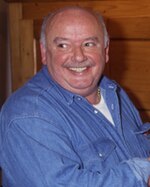
The Hitler Diaries (German: Hitler-Tagebücher) were a series of sixty volumes of journals purportedly written by Adolf Hitler, but forged by Konrad Kujau between 1981 and 1983. The diaries were purchased in 1983 for 9.3 million Deutsche Marks (£2.3 million or $3.7 million) by the West German news magazine Stern, which sold serialisation rights to several news organisations. One of the publications involved was The Sunday Times, who asked their independent director, the historian Hugh Trevor-Roper, to authenticate the diaries; he did so, pronouncing them genuine. At the press conference to announce the publication, Trevor-Roper announced that on reflection he had changed his mind, and other historians also raised questions concerning their validity. Rigorous forensic analysis, which had not been performed previously, quickly confirmed that the diaries were fakes.
Kujau, born and raised in East Germany, had a history of petty crime and deception. In the mid-1970s he began selling Nazi memorabilia which he had smuggled from the East, but found he could raise the prices by forging additional authentication details to associate ordinary souvenirs to the Nazi leaders. He began forging paintings by Hitler and an increasing number of notes, poems and letters, until he produced his first diary in the mid-to-late 1970s. The West German journalist with Stern who "discovered" the diaries and was involved in their purchase was Gerd Heidemann, who had an obsession with the Nazis. When Stern started buying the diaries, Heidemann stole a significant proportion of the money.
Kujau and Heidemann spent time in prison for their parts in the fraud, and several newspaper editors lost their jobs. The story of the scandal was the basis for the films Selling Hitler (1991) for the British channel ITV, the German film Schtonk! (1992), and the television series Faking Hitler (2021). (Full article...)
Selected article 14
Portal:Germany/Selected article/14
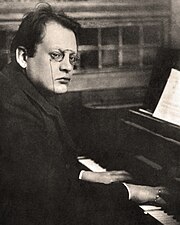
Der 100. Psalm (The 100th Psalm), Op. 106, is a composition in four movements by Max Reger in D major for mixed choir and orchestra, a late Romantic setting of Psalm 100. Reger began composing the work in 1908 for the 350th anniversary of Jena University. The occasion was celebrated that year with the premiere of Part I, conducted by Fritz Stein on 31 July. Reger completed the composition in 1909. It was published that year and premiered simultaneously on 23 February 1910 in Chemnitz, conducted by the composer, and in Breslau, conducted by Georg Dohrn.
Reger structured the text in four movements, as a choral symphony. He scored it for a four-part choir with often divided voices, a large symphony orchestra, and organ. He requested additional brass players for the climax in the last movement when four trumpets and four trombones play the melody of Luther's chorale "Ein feste Burg ist unser Gott". Reger used both late-Romantic features of harmony and dynamics, and polyphony in the Baroque tradition, culminating in the final movement, a double fugue with the added instrumental cantus firmus.
In 1922, the biographer Eugen Segnitz noted that this work, of intense expression, was unique in the sacred music of its period, with its convincing musical interpretation of the biblical text and manifold shades of emotion. Paul Hindemith wrote a trimmed adaption which probably helped to keep the work in the repertory, and François Callebout wrote an organ version, making the work accessible for smaller choirs. The organ version was first performed in 2003, in Wiesbaden where the composer studied. The celebration of the Reger Year 2016, reflecting the centenary of the composer's death, led to several performances of Der 100. Psalm. (Full article...)
Selected article 15
Portal:Germany/Selected article/15

Jürgen Ehlers (German: [ˈjʏʁɡŋ̩ ˈeːlɐs]; 29 December 1929 – 20 May 2008) was a German physicist who contributed to the understanding of Albert Einstein's theory of general relativity. From graduate and postgraduate work in Pascual Jordan's relativity research group at Hamburg University, he held various posts as a lecturer and, later, as a professor before joining the Max Planck Institute for Astrophysics in Munich as a director. In 1995, he became the founding director of the newly created Max Planck Institute for Gravitational Physics in Potsdam, Germany.
Ehlers' research focused on the foundations of general relativity as well as on the theory's applications to astrophysics. He formulated a suitable classification of exact solutions to Einstein's field equations and proved the Ehlers–Geren–Sachs theorem that justifies the application of simple, general-relativistic model universes to modern cosmology. He created a spacetime-oriented description of gravitational lensing and clarified the relationship between models formulated within the framework of general relativity and those of Newtonian gravity. In addition, Ehlers had a keen interest in both the history and philosophy of physics and was an ardent populariser of science. (Full article...)
Selected article 16
Portal:Germany/Selected article/16

SMS Hindenburg was a battlecruiser of the German Kaiserliche Marine (Imperial Navy), the third ship of the Derfflinger class, built to a slightly modified design. She carried the same battery of eight 30.5 cm (12 in) guns, but in improved turrets that allowed them to fire further. The ship was also slightly larger and faster than her two sister ships. She was named in honor of Field Marshal Paul von Hindenburg, the victor of the Battle of Tannenberg and the Battle of the Masurian Lakes, as well as Supreme Commander of the German armies from 1916. The ship was the last capital ship of any type built for the German navy during World War I.
Hindenburg was commissioned late in the war and as a result had a brief service career. The ship took part in a handful of short fleet operations as the flagship of I Scouting Group in 1917–18, though saw no major action. The proposed final sortie of the fleet in the last weeks of the war came to nothing when the crews of the capital ships mutinied. Hindenburg was subsequently interned with the rest of the German battlecruisers at Scapa Flow in November 1918. Rear Admiral Ludwig von Reuter ordered the ships be scuttled on 21 June 1919. Hindenburg was the last of the ships to sink. She was raised in 1930 and broken up for scrap over the following two years. (Full article...)
Selected article 17
Portal:Germany/Selected article/17

James Franck (German pronunciation: [ˈdʒɛɪ̯ms ˈfʁaŋk] ⓘ; 26 August 1882 – 21 May 1964) was a German physicist who won the 1925 Nobel Prize for Physics with Gustav Hertz "for their discovery of the laws governing the impact of an electron upon an atom". He completed his doctorate in 1906 and his habilitation in 1911 at the Frederick William University in Berlin, where he lectured and taught until 1918, having reached the position of professor extraordinarius. He served as a volunteer in the German Army during World War I. He was seriously injured in 1917 in a gas attack and was awarded the Iron Cross 1st Class.
Franck became the Head of the Physics Division of the Kaiser Wilhelm Gesellschaft for Physical Chemistry. In 1920, Franck became professor ordinarius of experimental physics and Director of the Second Institute for Experimental Physics at the University of Göttingen. While there he worked on quantum physics with Max Born, who was Director of the Institute of Theoretical Physics. His work included the Franck–Hertz experiment, an important confirmation of the Bohr model of the atom. He promoted the careers of women in physics, notably Lise Meitner, Hertha Sponer and Hilde Levi.
After the Nazi Party came to power in Germany in 1933, Franck resigned his post in protest against the dismissal of fellow academics. He assisted Frederick Lindemann in helping dismissed Jewish scientists find work overseas, before he left Germany in November 1933. After a year at the Niels Bohr Institute in Denmark, he moved to the United States, where he worked at Johns Hopkins University in Baltimore and then the University of Chicago. During this period he became interested in photosynthesis.
Franck participated in the Manhattan Project during World War II as Director of the Chemistry Division of the Metallurgical Laboratory. He was also the chairman of the Committee on Political and Social Problems regarding the atomic bomb, which is best known for the compilation of the Franck Report, which recommended that the atomic bombs not be used on the Japanese cities without warning. (Full article...)
Selected article 18
Portal:Germany/Selected article/18

The coat of arms of Munich (Münchner Wappen) depicts a young monk dressed in black holding a red book. It has existed in a similar form since the 13th century, though at certain points in its history it has not depicted the central figure of the monk at all. As the German name for Munich, München, means Home of Monks, the monk in this case is a self-explanatory symbol (canting arms) who represents the city of Munich.
Appearing on a document of 28 May 1239, the oldest seal of Munich has a picture of a monk wearing an open hood. While all seal impressions show the monk with the book in one hand and three outstretched fingers in the other, the monk has varied slightly, appearing in profile, then later full-faced and bare-headed. By the 19th century the figure was portrayed as youthful and became known as the Münchner Kindl or Munich Child. The coat of arms in its current form was created in 1957 and is still an important symbol of the Bavarian state capital. (Full article...)
Selected article 19
Portal:Germany/Selected article/19

Wings of Desire (German: Der Himmel über Berlin, pronounced [deːɐ̯ ˈhɪml̩ ˈʔyːbɐ bɛɐ̯ˈliːn] ⓘ; lit. 'The Heaven/Sky over Berlin') is a 1987 romantic fantasy film written by Wim Wenders, Peter Handke and Richard Reitinger, and directed by Wenders. The film is about invisible, immortal angels who populate Berlin and listen to the thoughts of its human inhabitants, comforting the distressed. Even though the city is densely populated, many of the people are isolated or estranged from their loved ones. One of the angels, played by Bruno Ganz, falls in love with a beautiful, lonely trapeze artist, played by Solveig Dommartin. The angel chooses to become mortal so that he can experience human sensory pleasures, ranging from enjoying food to touching a loved one, and so that he can discover human love with the trapeze artist.
Inspired by art depicting angels visible around West Berlin, at the time encircled by the Berlin Wall, Wenders and author Peter Handke conceived of the story and continued to develop the screenplay throughout the French and German co-production. The film was shot by Henri Alekan in both colour and a sepia-toned black-and-white, the latter being used to represent the world as seen by the angels. The cast includes Otto Sander, Curt Bois and Peter Falk.
For Wings of Desire, Wenders won awards for Best Director at both the Cannes Film Festival and European Film Awards. The film was a critical and financial success, and academics have interpreted it as a statement of the importance of cinema, libraries, the circus, or German unity, containing New Age, religious, secular or other themes.
It was followed by a sequel, Faraway, So Close!, released in 1993. City of Angels, a U.S. remake, was released in 1998. In 1990, numerous critics named Wings of Desire as one of the best films of the 1980s. (Full article...)
Selected article 20
Portal:Germany/Selected article/20
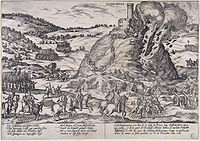
The siege of Godesberg, 18 November – 17 December 1583, was the first major siege of the Cologne War (1583–1589). Seeking to wrest control of an important fortification, Bavarian and mercenary soldiers surrounded the Godesberg, and the village then of the same name, now Bad Godesberg, located at its foot. On top of the mountain sat a formidable fortress, similarly named Godesburg, built in the early 13th century during a contest over the election of two competing archbishops.
Towering over the Rhine valley, the Godesburg's strategic position commanded the roads leading to and from Bonn, the Elector of Cologne's capital city, and Cologne, the region's economic powerhouse. Over time, the Electors strengthened its walls and heightened its towers. They added a small residence in the 14th century and the donjon (also called a Bergfried or keep) developed as a stronghold of the Electoral archives and valuables. By the mid-16th century, the Godesburg was considered nearly impregnable and had become a symbol of the dual power of the Prince-electors and Archbishops of Cologne, one of the wealthiest ecclesiastical territories in the Holy Roman Empire. The Cologne War, a feud between the Protestant Elector, Gebhard, Truchsess of Waldburg, and the Catholic Elector, Ernest of Bavaria, was yet another schismatic episode in the Electoral and archdiocesan history.
The Godesburg came under attack from Bavarian forces in November 1583. It resisted a lengthy cannonade by the attacking army; finally, sappers tunneled into the basalt core of the mountain, placed 680 kilograms (1,500 lb) of powder into the tunnel and blew up a significant part of the fortifications. The explosion killed many of the defending troops, but the resulting rubble impeded the attackers' progress, and the remaining defenders continued to offer staunch resistance. Only when some of the attackers entered the castle's inner courtyard through the latrine system were the Bavarians able to overcome their opponents. The Godesburg's commander and some surviving defenders took refuge in the keep; using prisoners held in the dungeons as hostages, the commander negotiated safe passage for himself, his wife and his lieutenant. The others who were left in the keep—men, women and children—were killed. Nearby Bonn fell to the Bavarians the following month. (Full article...)
Selected article 21
Portal:Germany/Selected article/21

Stefan Lochner (the Dombild Master or Master Stefan; c. 1410 – late 1451) was a German painter working in the late International Gothic period. His paintings combine that era's tendency toward long flowing lines and brilliant colours with the realism, virtuoso surface textures and innovative iconography of the early Northern Renaissance. Based in Cologne, a commercial and artistic hub of northern Europe, Lochner was one of the most important German painters before Albrecht Dürer. Extant works include single-panel oil paintings, devotional polyptychs and illuminated manuscripts, which often feature fanciful and blue-winged angels. Today some thirty-seven individual panels are attributed to him with confidence.
Less is known of his life. Art historians associating the Dombild Altarpiece master with the historical Stefan Lochner believe he was born in Meersburg in south-west Germany around 1410, and that he spent some of his apprenticeship in the Low Countries. Records further indicate that his career developed quickly but was cut short by an early death. We know that he was commissioned around 1442 by the Cologne council to provide decorations for the visit of Emperor Frederick III, a major occasion for the city. Records from the following years indicate growing wealth and the purchase of a number of properties around the city. Thereafter he seems to have over-extended his finances and fallen into debt. Plague hit Cologne in 1451 and there, apart from the records of creditors, mention of Stephan Lochner ends; it is presumed he died that year, aged around 40. (Full article...)
Selected article 22
Portal:Germany/Selected article/22

The Night of the Long Knives (German: Nacht der langen Messer), also called the Röhm purge (German: Der Röhm-Putsch) or Operation Hummingbird (German: Unternehmen Kolibri), was a purge that took place in Nazi Germany from 30 June to 2 July 1934. Chancellor Adolf Hitler, urged on by Hermann Göring and Heinrich Himmler, ordered a series of political extrajudicial executions intended to consolidate his power and alleviate the concerns of the German military about the role of Ernst Röhm and the Sturmabteilung (SA), the Nazis' paramilitary organization, known colloquially as "Brownshirts". Nazi propaganda presented the murders as a preventive measure against an alleged imminent coup by the SA under Röhm – the so-called Röhm Putsch.
The primary instruments of Hitler's action, which carried out most of the killings, were the Schutzstaffel (SS) paramilitary force under Himmler and its Security Service (SD), and Gestapo (secret police) under Reinhard Heydrich. Göring's personal police battalion also took part in the killings. Many of those killed in the purge were leaders of the SA, the best-known being Röhm himself, the SA's chief of staff and one of Hitler's longtime supporters and allies. Leading members of the Strasserist faction of the Nazi Party, including its leader Gregor Strasser, were also killed, as were establishment conservatives and anti-Nazis, such as former Chancellor Kurt von Schleicher and Bavarian politician Gustav Ritter von Kahr, who had helped suppress Hitler's Munich Beer Hall Putsch in 1923. The murders of SA leaders were also intended to improve the image of the Hitler government with a German public that was increasingly critical of thuggish SA tactics. (Full article...)
Selected article 23
Portal:Germany/Selected article/23

Fußball-Club Bayern München e. V. (FCB, pronounced [ˈfuːsbalˌklʊp ˈbaɪɐn ˈmʏnçn̩] ⓘ), also known as FC Bayern (pronounced [ˌɛft͡seː ˈbaɪɐn] ⓘ), Bayern Munich, or simply Bayern, is a German professional sports club based in Munich, Bavaria. It is best known for its professional men's association football team, which plays in the Bundesliga, the top tier of the German football league system. Bayern is the most successful club in German football history, having won a record 33 national titles, including eleven consecutively from 2013 to 2023, and 20 national cups, along with numerous European honours.
Bayern Munich was founded in 1900 by eleven players, led by Franz John. Although Bayern won its first national championship in 1932, the club was not selected for the Bundesliga at its inception in 1963. The club had its period of greatest success in the mid-1970s when, under the captaincy of Franz Beckenbauer, they won the European Cup three consecutive times (1974–1976). Overall, Bayern have won six European Cup/UEFA Champions League titles (a German record), winning their sixth title in the 2020 final as part of the Treble, after which it became the second European club to achieve the feat twice. Bayern has also won one UEFA Cup, one European Cup Winners' Cup, two UEFA Super Cups, two FIFA Club World Cups and two Intercontinental Cups, making it one of the most successful European clubs internationally, and the only German club to have won both international titles. Bayern players have accumulated five Ballon d'Or awards, two The Best FIFA Men's Player awards, four European Golden Shoe and three UEFA Men's Player of the Year awards, including UEFA Club Footballer of the Year. (Full article...)
Selected article 24
Portal:Germany/Selected article/24

The formal unification of Germany into a politically and administratively integrated nation state officially occurred on 18 January 1871 at the Versailles Palace's Hall of Mirrors in France. Princes of the German states gathered there to proclaim Wilhelm of Prussia as Emperor Wilhelm of the German Empire after the French capitulation in the Franco-Prussian War. Unofficially, the transition of the German-speaking states into a federated organization of states occurred over nearly a century of experimentation. Unification exposed several glaring religious, linguistic, and cultural differences between and among the inhabitants of the new nation, suggesting that 1871 represents one moment in a continuum of unification processes.
The Holy Roman Empire of the German Nation had been informally dissolved in 1806 with the abdication of Emperor Francis II during the Napoleonic Wars. Despite the legal, administrative, and political disruption caused by the dissolution of the Empire, the people of the German-speaking areas of the old Empire had a common linguistic, cultural and legal tradition further enhanced by their shared experience in the French Revolutionary Wars. More...
Selected article 25
Portal:Germany/Selected article/25

Knut (5 December 2006 – 19 March 2011) was a polar bear who was born in captivity at the Berlin Zoological Garden. Rejected by his mother at birth, he was raised by zookeepers. He was the first polar bear cub to survive past infancy at the Berlin Zoo in more than 30 years. At one time the subject of international controversy, he became a tourist attraction and commercial success. After the German tabloid newspaper Bild ran a quote from an animal rights activist that decried keeping the cub in captivity, fans worldwide rallied in support of his being hand-raised by humans.
Knut became the center of a mass media phenomenon dubbed "Knutmania" that spanned the globe and spawned toys, media specials, DVDs, and books. Because of this, the cub was largely responsible for a significant increase in revenue, estimated at about five million euros, at the Berlin Zoo in 2007. Zoo attendance figures for the year had increased by an estimated 30 percent. On 19 March 2011, Knut died unexpectedly at the age of four. His death was caused by drowning after he collapsed into his enclosure's pool while suffering from encephalitis. More ...
Selected article 26
Portal:Germany/Selected article/26

The Göttingen Seven (German: Göttinger Sieben) were a group of seven liberal professors at University of Göttingen. In 1837, they protested against the annullment of the constitution of the Kingdom of Hanover by its new ruler, King Ernest Augustus, and refused to swear an oath to the king. The company of seven was led by historian Friedrich Christoph Dahlmann, who himself was one of the key advocates of the previous constitution. The other six were the Germanist brothers Wilhelm and Jacob Grimm (famed fairy tale and folk tale writers and storytellers, known together as the Brothers Grimm), jurist Wilhelm Eduard Albrecht, historian Georg Gottfried Gervinus, physicist Wilhelm Eduard Weber, and theologian and orientalist Heinrich Georg August Ewald. (Full article...)
Selected article 27
Portal:Germany/Selected article/27

The Free Association of German Trade Unions (abbreviated FVdG; sometimes also translated as Free Association of German Unions or Free Alliance of German Trade Unions) was a trade union federation in Imperial and early Weimar Germany. It was founded in 1897 in Halle under the name Representatives' Centralization of Germany as the national umbrella organization of the localist current of the German labor movement. The localists rejected the centralization in the labor movement following the sunset of the Anti-Socialist Laws in 1890 and preferred grassroots democratic structures. The lack of a strike code soon led to conflict within the organization. Various ways of providing financial support for strikes were tested before a system of voluntary solidarity was agreed upon in 1903. During the years following its formation, the FVdG began to adopt increasingly radical positions. During the German socialist movement's debate over the use of mass strikes, the FVdG advanced the view that the general strike must be a weapon in the hands of the working class. Immediately after the November Revolution, the FVdG very quickly became a mass organization. It was particularly attractive to miners from the Ruhr area opposed to the mainstream unions' reformist policies. In December 1919, the federation merged with several minor left communist unions to become the Free Workers' Union of Germany (FAUD). More...
Selected article 28
Portal:Germany/Selected article/28

Michael Schumacher (German: [ˈmɪçaːʔeːl ˈʃuːmaxɐ] ⓘ; born 3 January 1969) is a German former racing driver who competed in Formula One for Jordan, Benetton, Ferrari, and Mercedes. Schumacher has a joint-record seven World Drivers' Championship titles (tied with Lewis Hamilton); at the time of his retirement from the sport in 2012, he also held the records for the most wins (91), pole positions (68), and podium finishes (155)—which have since been broken by Hamilton—while he maintains the record for consecutive Drivers' Championships and number of total fastest laps (77), among others. (Full article...)
Selected article 29
Portal:Germany/Selected article/29

Auschwitz concentration camp (German: Konzentrationslager Auschwitz, pronounced [kɔntsɛntʁaˈtsi̯oːnsˌlaːɡɐ ˈʔaʊʃvɪts] ⓘ; also KL Auschwitz or KZ Auschwitz) was a complex of over 40 concentration and extermination camps operated by Nazi Germany in occupied Poland (in a portion annexed into Germany in 1939) during World War II and the Holocaust. It consisted of Auschwitz I, the main camp (Stammlager) in Oświęcim; Auschwitz II-Birkenau, a concentration and extermination camp with gas chambers; Auschwitz III-Monowitz, a labour camp for the chemical conglomerate IG Farben; and dozens of subcamps. The camps became a major site of the Nazis' Final Solution to the Jewish question.
After Germany initiated World War II by invading Poland in September 1939, the Schutzstaffel (SS) converted Auschwitz I, an army barracks, into a prisoner-of-war camp. The initial transport of political detainees to Auschwitz consisted almost solely of Poles (for whom the camp was initially established). For the first two years, the majority of inmates were Polish. In May 1940, German criminals brought to the camp as functionaries established the camp's reputation for sadism. Prisoners were beaten, tortured, and executed for the most trivial of reasons. The first gassings—of Soviet and Polish prisoners—took place in block 11 of Auschwitz I around August 1941. (Full article...)
Selected article 30
Portal:Germany/Selected article/30

The Battle of Schellenberg, also known as the Battle of Donauwörth, was fought during the War of the Spanish Succession on 2 July 1704. The assault on the Schellenberg heights on the River Danube was part of the Duke of Marlborough’s campaign to rescue Vienna, the capital of Habsburg Austria, from King Louis XIV's forces ranged in southern Germany. Marlborough had commenced his march from Bedburg, near Cologne, on 19 May; within five weeks the Duke had reached the Danube where he sought to bring the Elector of Bavaria's forces to open battle. However, the Allied army’s lines of supply were established in Franconia and central Germany, too far north to be convenient once the line of the Danube had been crossed. It was therefore necessary not only to secure a bridge across the river, but also to obtain a new supply base. To achieve these objectives, the Allied commanders chose the walled town of Donauwörth, overlooked by the fortress on the Schellenberg Heights. Once the Franco-Bavarian commanders knew of the Allies’ objective, they dispatched Count d’Arco with 12,000 men to strengthen and hold the position. Marlborough’s co-commander, Louis of Baden, preferred a protracted siege; however, with news arriving that Marshal Tallard was approaching with French reinforcements, the Duke insisted on an immediate assault. Within two hours the Allies had secured their objective, but at considerable cost; the coup de main had cost the Allies some 5,000 casualties, and the defenders, 8,000. Nevertheless, with a supply base and river crossing firmly secured, the Duke of Marlborough – soon to be reinforced by Prince Eugene of Savoy – could now fight the battle he had desired. More...
Selected article 31
Portal:Germany/Selected article/31

Annelies Marie Frank (German: [ˈanə(liːs maˈʁiː) ˈfʁaŋk] ⓘ, Dutch: [ˌɑnəˈlis maːˈri ˈfrɑŋk, ˈɑnə ˈfrɑŋk] ⓘ; 12 June 1929 – c. February or March 1945) was a German-born Jewish girl who kept a diary in which she documented life in hiding under Nazi persecution during the German occupation of the Netherlands. She is a celebrated diarist who described everyday life from her family hiding place in an Amsterdam attic. One of the most-discussed Jewish victims of the Holocaust, she gained fame posthumously with the 1947 publication of The Diary of a Young Girl (originally Het Achterhuis in Dutch, lit. 'the back house'; English: The Secret Annex), in which she documents her life in hiding from 1942 to 1944 — it is one of the world's best-known books and has been the basis for several plays and films.
Frank was born in Frankfurt, Germany, in 1929. In 1934, when she was four-and-a-half, she and her family moved to Amsterdam, Netherlands, after Adolf Hitler and the Nazi Party gained control over Germany. She spent most of her life in or around Amsterdam. By May 1940, the Franks were trapped in Amsterdam by the German occupation of the Netherlands. Anne lost her German citizenship in 1941 and became stateless. Despite spending most of her life in the Netherlands and being a de facto Dutch national, she never officially became a Dutch citizen. As persecutions of the Jewish population increased in July 1942, they went into hiding in concealed rooms behind a bookcase in the building where Anne's father, Otto Frank, worked. The hiding place is notably referred to as the "secret annex". Until the family's arrest by the Gestapo on 4 August 1944, Frank kept and regularly wrote in a diary she had received as a birthday present in 1942. (Full article...)
Selected article 32
Portal:Germany/Selected article/32
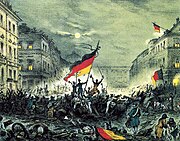
The flag of Germany is a tricolour consisting of three equal horizontal bands displaying the national colours of Germany: black, red and gold.
The black-red-gold tricolour first appeared in the early 19th century and achieved prominence during the 1848 revolution. The short-lived Frankfurt Parliament of 1848–50 proposed the tricolour as a flag for a united and democratic German state. With the formation of the Weimar Republic after World War I, the tricolour was adopted as the national flag of Germany. Following World War II, the tricolour was designated as the flag of both West and East Germany. The two flags were identical until 1959, when socialist symbols were added to the East German flag. Since reunification on 3 October 1990, the black-red-gold tricolour has remained the flag of Germany.
The flag of Germany has not always used black, red and gold as its colours. After the Austro–Prussian War in 1866, the Prussian-dominated North German Confederation adopted a tricolour of black-white-red as its flag. This flag later became the flag of the German Empire, formed following the unification of Germany in 1871, and was used until 1918. Black, white and red were reintroduced as the German national colours with the establishment of Nazi Germany in 1933.
The colour schemes of black-red-gold and black-white-red have played an important role in the history of Germany and have had various meanings. The colours of the modern flag are associated with the republican democracy formed after World War II, and represent German unity and freedom: not only the freedom of Germany, but also the personal freedom of the German people. More...
Selected article 33
Portal:Germany/Selected article/33

Amalie Emmy Noether (March 23, 1882 – April 14, 1935) was a German Jewish mathematician who is known for her seminal contributions to abstract algebra. Often described as the most important woman in the history of mathematics, she revolutionized the theories of rings, fields, and algebras. She is also known for her contributions to modern theoretical physics, especially for the first Noether's theorem which explains the connection between symmetry and conservation laws.
After completing her dissertation in 1907 under the supervision of Paul Gordan, she worked at the Mathematical Institute of Erlangen without pay for seven years. In 1915, she was invited by David Hilbert and Felix Klein to join the mathematics department at the University of Göttingen. The Philosophical faculty objected, however, and she spent four years lecturing under Hilbert's name. Her Habilitation process was approved in 1919, paving the way for her to obtain the rank of Privatdozent. She remained at Göttingen until 1933, where she was a leading member of a world-renowned center of mathematical research. By the time she delivered a major address at the 1932 International Congress of Mathematicians in Zürich, her algebraic acumen was recognized around the world. The following year, Germany's Nazi government had her fired from Göttingen, and she moved to the United States, where she took a position at Bryn Mawr College in Pennsylvania. In 1935, she underwent surgery for an ovarian cyst and, despite signs of speedy recovery, died four days later at the age of 53. More...
Selected article 34
Portal:Germany/Selected article/34

Nazi Germany, officially known as the German Reich and later the Greater German Reich, is a term used to describe the German state between 1933 and 1945, when Adolf Hitler and the Nazi Party controlled the country, transforming it into a totalitarian dictatorship. The Third Reich, meaning "Third Realm" or "Third Empire", referred to the Nazi claim that Nazi Germany was the successor to the earlier Holy Roman Empire (800–1806) and German Empire (1871–1918). The Third Reich, which the Nazis referred to as the Thousand-Year Reich, ended in May 1945, after only 12 years, when the Allies defeated Germany and entered the capital, Berlin, ending World War II in Europe.
After Hitler was appointed Chancellor of Germany by the President of the Weimar Republic Paul von Hindenburg on 30 January 1933, the Nazi Party began to eliminate political opposition and consolidate power. Hindenburg died on 2 August 1934, and Hitler became dictator by merging the powers of the chancellery and presidency. A 1934 German referendum confirmed Hitler as sole Führer (leader). Power was centralised in Hitler's person, and his word became the highest law. The government was not a coordinated, cooperating body, but rather a collection of factions struggling to amass power. In the midst of the Great Depression, the Nazis restored economic stability and ended mass unemployment using heavy military spending. Financed by deficit spending, the regime undertook extensive public works projects, including the Autobahnen (motorways) and a massive secret rearmament program, forming the Wehrmacht (armed forces). The return to economic stability boosted the regime's popularity. Germany made increasingly aggressive territorial demands, threatening war if they were not met. Germany seized Austria in the Anschluss of 1938, and demanded and received the Sudetenland region of Czechoslovakia. Germany signed a non-aggression pact with the Soviet Union and invaded Poland on 1 September 1939, launching World War II in Europe. In alliance with Italy and other Axis powers, Germany conquered most of Europe by 1940 and threatened Great Britain.
Racism, Nazi eugenics, anti-Slavism, and especially antisemitism were central ideological features of the regime. The Germanic peoples were considered by the Nazis to be the "master race", the purest branch of the Aryan race. Jews, Romani people, Slavs, homosexuals, liberals, socialists, communists, other political opponents, Jehovah Witnesses, those who refused to work, and other "undesirables" were imprisoned, exiled, or murdered. Christian churches and citizens that opposed Hitler's rule were oppressed and leaders imprisoned. Education focused on racial biology, population policy, and fitness for military service. Career and educational opportunities for women were curtailed. Nazi Propaganda Ministry disseminated films, antisemitic canards, and organized mass rallies; fostering a pervasive cult of personality around Adolf Hitler to influence public opinion. The government controlled artistic expression, promoting specific art forms and banning or discouraging others. Genocide, mass murder, and large-scale forced labour became hallmarks of the regime; the implementation of the regime's racial policies culminated in the Holocaust. (Full article...)
Selected article 35
Portal:Germany/Selected article/35

The Germany women's national football team (German: Deutsche Fußballnationalmannschaft der Frauen) represents Germany in international women's football. The team is governed by the German Football Association (DFB).
The Germany national team is one of the most successful in women's football. They are two-time world champions, having won the 2003 and 2007 tournaments. The team has won eight of the thirteen UEFA European Championships, claiming six consecutive titles between 1995 and 2013. They, along with the Netherlands, are one of the two nations that have won both the women's and men's European tournament. Germany has won Olympic gold in 2016, after three consecutive bronze medals at the Women's Olympic Football Tournament, finishing third in 2000, 2004 and 2008. Birgit Prinz holds the record for most appearances and is the team's all-time leading goalscorer. Prinz has also set international records; she has received the FIFA World Player of the Year award three times and is the joint second overall top goalscorer at the Women's World Cup. (Full article...)
Selected article 36
Portal:Germany/Selected article/36

In early 1914, the German government sent Detzner to explore and chart the interior of Kaiser-Wilhelmsland, the imperial protectorate on the island of New Guinea. When World War I broke out in Europe, he was well into the interior, without radio contact. He refused to surrender to Australian troops when they occupied German New Guinea, concealing himself in the jungle with a band of approximately 20 soldiers. For four years, Detzner and his troops provocatively marched through the bush, singing "Watch on the Rhine" and flying the German Imperial flag. He led at least one expedition from the Huon Peninsula to the north coast, and a second by a mountain route, to attempt an escape to the neutral Dutch colony. He explored areas of the Guinean interior formerly unseen by Europeans and surrendered in full dress uniform, flying the Imperial flag, to Australian forces in January 1919.
Detzner received a hero's welcome when he returned to Germany. More...
Selected article 37
Portal:Germany/Selected article/37

Richard Wagner (22 May 1813 – 13 February 1883) was a German composer, theatre director, polemicist, and conductor who is primarily known for his operas (or, as some of his later works were later known, "music dramas"). Unlike most opera composers, Wagner wrote both the libretto and the music for each of his stage works. Initially establishing his reputation as a composer of works in the romantic vein of Weber and Meyerbeer, Wagner revolutionised opera through his concept of the Gesamtkunstwerk ("total work of art"), by which he sought to synthesise the poetic, visual, musical and dramatic arts, with music subsidiary to drama. He described this vision in a series of essays published between 1849 and 1852. Wagner realised these ideas most fully in the first half of the four-opera cycle Der Ring des Nibelungen (The Ring of the Nibelung).
His compositions, particularly those of his later period, are notable for their complex textures, rich harmonies and orchestration, and the elaborate use of leitmotifs—musical phrases associated with individual characters, places, ideas or plot elements. His advances in musical language, such as extreme chromaticism and quickly shifting tonal centres, greatly influenced the development of classical music. His Tristan und Isolde is sometimes described as marking the start of modern music. More...
Selected article 38
Portal:Germany/Selected article/38

The inner German border (German: innerdeutsche Grenze or deutsch-deutsche Grenze; initially also Zonengrenze) was the border between the German Democratic Republic (GDR, East Germany) and the Federal Republic of Germany (FRG, West Germany) from 1949 to 1990. Not including the similar but physically separate Berlin Wall, the border was 1,393 kilometres (866 mi) long and ran from the Baltic Sea to Czechoslovakia.
It was formally established on 1 July 1945 as the boundary between the Western and Soviet occupation zones of former Nazi Germany. On the eastern side, it was made one of the world's most heavily fortified frontiers, defined by a continuous line of high metal fences and walls, barbed wire, alarms, anti-vehicle ditches, watchtowers, automatic booby traps and minefields. It was patrolled by 50,000 armed GDR guards who faced tens of thousands of West German, British and US guards and soldiers. In the hinterlands behind the border were more than a million North Atlantic Treaty Organisation (NATO) and Warsaw Pact troops. More...
Selected article 39
Portal:Germany/Selected article/39

The Brazil vs Germany football match (also known by its score as 7–1) that took place on 8 July 2014 at the Mineirão stadium in Belo Horizonte was the first of two semi-final matches of the 2014 FIFA World Cup.
Both Brazil and Germany reached the semi-finals with an undefeated record in the competition, with the Brazilians' quarter-final with Colombia causing them to lose forward Neymar to injury, and defender and captain Thiago Silva to accumulation of yellow cards. Despite the absence of these players, a close match was expected, given both teams performed comparably well throughout the tournament. Also, both were regarded as two of the biggest traditional FIFA World Cup forces, sharing eight tournaments won and having previously met in the 2002 FIFA World Cup Final, where Brazil won 2–0 and earned their fifth title. (Full article...)
Selected article 40
Portal:Germany/Selected article/40

Karl Marx (5 May 1818 – 14 March 1883) was a German scientist, philosopher, economist, sociologist, journalist, and revolutionary socialist. Born in Trier to a middle-class family, he later studied political economy and Hegelian philosophy. As an adult, Marx became stateless and spent much of his life in London, England, where he continued to develop his thought in collaboration with German thinker Friedrich Engels and published various works, the most well-known being the 1848 pamphlet The Communist Manifesto. His work has since influenced subsequent intellectual, economic, and political history.
Marx's theories about society, economics and politics—collectively understood as Marxism—hold that human societies develop through class struggle; in capitalism, this manifests itself in the conflict between the ruling classes (known as the bourgeoisie) that control the means of production and working classes (known as the proletariat) that enable these means by selling their labour for wages. Through his theories of alienation, value, commodity fetishism, and surplus value, Marx argued that capitalism facilitated social relations and ideology through commodification, inequality, and the exploitation of labour. Employing a critical approach known as historical materialism, Marx propounded the theory of base and superstructure, asserting that the cultural and political conditions of society, as well as its notions of human nature, are largely determined by obscured economic foundations. These economic critiques were set out in influential works such as the three volumes, published between 1867 and 1894, that comprise Das Kapital. More...
Selected article 41
Portal:Germany/Selected article/41

Christ lag in Todes Banden (also spelled Todesbanden; "Christ lay in death's bonds" or "Christ lay in the snares of death"), BWV 4, is a cantata for Easter by German composer Johann Sebastian Bach, one of his earliest church cantatas. It is agreed to be an early work partly for stylistic reasons and partly because there is evidence that it was probably written for a performance in 1707. Bach went on to complete many other works in the same genre, contributing complete cantata cycles for all occasions of the liturgical year. John Eliot Gardiner described it as Bach's "first-known attempt at painting narrative in music".
Christ lag in Todes Banden is a chorale cantata, a style in which both text and music are based on a hymn. In this instance, the source was Martin Luther's hymn of the same name, the main hymn for Easter in the Lutheran church. The composition is based on the seven stanzas of the hymn and its tune, which was derived from Medieval models. Bach used the unchanged words of a stanza of the chorale in each of the seven vocal movements, in the format of chorale variations per omnes versus (for all stanzas), and he used its tune as a cantus firmus. After an opening sinfonia, the variations are arranged symmetrically: chorus–duet–solo–chorus–solo–duet–chorus, with the focus on the central fourth stanza about the battle between Life and Death. All movements are in E minor, and Bach achieves variety and intensifies the meaning of the text through many musical forms and techniques. (Full article...)
Selected article 42
Portal:Germany/Selected article/42
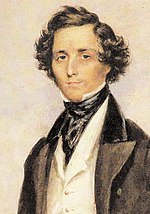
Felix Mendelssohn (3 February 1809 – 4 November 1847) was a German composer, pianist, organist and conductor of the early Romantic period.
A grandson of the philosopher Moses Mendelssohn, Felix Mendelssohn was born into a prominent Jewish family. He was brought up without religion until the age of seven, when he was baptised as a Reformed Christian. Mendelssohn was recognised early as a musical prodigy, but his parents were cautious and did not seek to capitalise on his talent.
Mendelssohn enjoyed early success in Germany, where he also revived interest in the music of Johann Sebastian Bach, and in his travels throughout Europe. He was particularly well received in Britain as a composer, conductor and soloist, and his ten visits there – during which many of his major works were premiered – form an important part of his adult career. His essentially conservative musical tastes, however, set him apart from many of his more adventurous musical contemporaries such as Franz Liszt, Richard Wagner, Charles-Valentin Alkan and Hector Berlioz. The Leipzig Conservatoire (now the University of Music and Theatre Leipzig), which he founded, became a bastion of this anti-radical outlook. More...
Selected article 43
Portal:Germany/Selected article/43
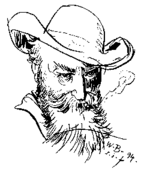
Wilhelm Busch (15 April 1832 – 9 January 1908) was a German humorist, poet, illustrator and painter. He published comic illustrated cautionary tales from 1859, achieving his most notable works in the 1870s. Busch's illustrations used wood engraving, and later, zincography.
Busch drew on contemporary parochial and city life, satirizing Catholicism, Philistinism, strict religious morality and bigotry. His comic text was colourful and entertaining, using onomatopoeia, neologisms and other figures of speech, and led to some work being banned by the authorities.
Busch was influential in both poetry and illustration, and became a source for future generations of comic artists. The Katzenjammer Kids was inspired by Busch's Max and Moritz, one of a number of imitations produced in Germany and the United States. The Wilhelm Busch Prize and the Wilhelm Busch Museum help maintain his legacy. His 175th anniversary in 2007 was celebrated throughout Germany. Busch remains one of the most influential poets and artists in Western Europe. More...
Selected article 44
Portal:Germany/Selected article/44

Francesca Gaetana Cosima Wagner (née Liszt; 24 December 1837 – 1 April 1930) was the daughter of the Hungarian composer and pianist Franz Liszt and Franco-German romantic author Marie d'Agoult. She became the second wife of the German composer Richard Wagner, and with him founded the Bayreuth Festival as a showcase for his stage works; after his death she devoted the rest of her life to the promotion of his music and philosophy. Commentators have recognised Cosima as the principal inspiration for Wagner's later works, particularly Parsifal.
In 1857, after a childhood largely spent under the care of her grandmother and with governesses, Cosima married the conductor Hans von Bülow. Although the marriage produced two children, it was largely a loveless union, and in 1863 Cosima began a relationship with Wagner, who was 24 years her senior. They married in 1870; after Wagner's death in 1883 she directed the Bayreuth Festival for more than 20 years, increasing its repertoire to form the Bayreuth canon of ten operas and establishing the festival as a major event in the world of musical theatre.
During her directorship, Cosima opposed theatrical innovations and adhered closely to Wagner's original productions of his works, an approach continued by her successors long after her retirement in 1907. She shared Wagner's convictions of German cultural and racial superiority, and under her influence, Bayreuth became increasingly identified with antisemitism. This was a defining aspect of Bayreuth for decades, into the Nazi era which closely followed her death there in 1930. Thus, although she is widely perceived as the saviour of the festival, her legacy remains controversial. (Full article...)
Selected article 45
Portal:Germany/Selected article/45

The Unionskirche (Union Church) is the active Protestant parish church of Idstein, a town in the Rheingau-Taunus district in the German state of Hesse. Idstein was a residence of the counts of Nassau. The church building in the center of the historic Altstadt (old town) dates back to the 14th century when it was built as a collegiate church. It became Lutheran during the Reformation. Its interior was adapted in the 17th century to become a Lutheran Predigt- und Hofkirche (sermon and court church). The most prominent decoration in the church is the series of 38 paintings by the Flemish painter Michael Angelo Immenraedt, an exponent of Flemish Baroque painting, and others. They follow a program of biblical scenes.
The church was named Unionskirche in 1917 to commemorate the union of Lutheran and Reformed Protestants in the Duchy of Nassau in August 1817, the first of its kind (before the Prussian Union in September of the same year). The Unionskirche is a recognized monument under the Hague Convention. It is used by the Protestant congregation, and it is open to other institutions as a concert venue, including concerts of the Rheingau Musik Festival. It features an organ built in 1912 by Walcker Orgelbau and retaining the historic case dating back to 1783.
The church was restored from 2012 to 2017, completed for 500 years since the Reformation and 200 years since the Union. The restoration was awarded the Hessischer Denkmalschutzpreis (Hessian monument preservation prize). (Full article...)
Selected article 46
Portal:Germany/Selected article/46

Dorothee Pesch (born 3 June 1964), known professionally as Doro Pesch or simply Doro, is a German heavy metal singer and the former frontwoman of heavy metal band Warlock. Dubbed the "Metal Queen", Doro's contributions to music and culture made her a global figure in metal culture for over three decades. The name Doro has also been associated with the touring band accompanying the singer, whose members have continuously changed in more than 20 years of uninterrupted activity, the most stable presences being those of bassist Nick Douglas and drummer Johnny Dee.
Doro started her career in garage bands in native Düsseldorf underground scene and achieved media visibility and some commercial success with Warlock in the 1980s. Warlock were starting to have an opening in the US market, when they went through many line-up changes and Pesch was left the only original member of the band. She started a solo career under the name Doro, in order to avoid legal battles between her record label PolyGram and her former manager. She released two albums in the US with producers Joey Balin and Gene Simmons, but they were not the breakthrough that she hoped. (Full article...)
Selected article 47
Portal:Germany/Selected article/47
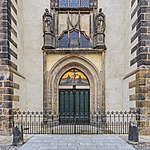
The Ninety-five Theses or Disputation on the Power of Indulgences (Latin: Disputatio pro declaratione virtutis indulgentiarum) are a list of propositions for an academic disputation written in 1517 by Martin Luther, professor of moral theology at the University of Wittenberg, Germany, that started the Protestant Reformation, a schism in the Catholic Church which profoundly changed Europe. They advance Luther's positions against what he saw as abusive practices by preachers selling plenary indulgences, which were certificates believed to reduce the temporal punishment for sins committed by the purchasers themselves or their loved ones in purgatory. In the Theses, Luther claimed that the repentance required by Christ in order for sins to be forgiven involves inner spiritual repentance rather than merely external sacramental confession. He argued that indulgences lead Christians to avoid true repentance and sorrow for sin, believing that they can forgo it by purchasing an indulgence. They also, according to Luther, discourage Christians from giving to the poor and performing other acts of mercy, believing that indulgence certificates were more spiritually valuable. Though Luther claimed that his positions on indulgences accorded with those of the pope, the Theses challenge a fourteenth-century papal bull stating that the pope could use the treasury of merit and the good deeds of past saints to forgive temporal punishment for sins. The Theses are framed as propositions to be argued in debate rather than necessarily representing Luther's opinions, but Luther later clarified his views in the Explanations of the Disputation Concerning the Value of Indulgences. More...
Selected article 48
Portal:Germany/Selected article/48

Baron Munchausen is a fictional German nobleman created by the German writer Rudolf Erich Raspe in his 1785 book Baron Munchausen's Narrative of his Marvellous Travels and Campaigns in Russia. The character is loosely based on a real baron, Hieronymus Karl Friedrich, Freiherr von Münchhausen (1720–1797).
Versions of the fictional Baron have appeared on stage, screen, radio, and television, as well as in other literary works. Though the Baron Munchausen stories are no longer well-known in English-speaking countries, they are still popular in continental Europe. The character has inspired numerous memorials and museums, and several medical conditions and other concepts are named after him, including Munchausen syndrome, the Münchhausen trilemma, and Munchausen numbers. More...
Selected article 49
Portal:Germany/Selected article/49

The Cabinet of Dr. Caligari (German: Das Cabinet des Dr. Caligari) is a 1920 German silent horror film, directed by Robert Wiene and written by Hans Janowitz and Carl Mayer. Considered the quintessential work of German Expressionist cinema, it tells the story of an insane hypnotist (Werner Krauss) who uses a somnambulist (Conrad Veidt) to commit murders. The film features a dark and twisted visual style, with sharp-pointed forms, oblique and curving lines, structures and landscapes that lean and twist in unusual angles, and shadows and streaks of light painted directly onto the sets.
The Cabinet of Dr. Caligari was released just as foreign film industries were easing restrictions on the import of German films following World War I, so it was screened internationally. Accounts differ as to its financial and critical success upon release, but modern film critics and historians have largely praised it as a revolutionary film. Critic Roger Ebert called it arguably "the first true horror film", and film reviewer Danny Peary called it cinema's first cult film and a precursor to arthouse films. Considered a classic, it helped draw worldwide attention to the artistic merit of German cinema and had a major influence on American films, particularly in the genres of horror and film noir. More...
Selected article 50
Portal:Germany/Selected article/50

Caspar David Friedrich (5 September 1774 – 7 May 1840) was a 19th-century German Romantic landscape painter, generally considered the most important German artist of his generation. He is best known for his mid-period allegorical landscapes which typically feature contemplative figures silhouetted against night skies, morning mists, barren trees or Gothic or megalithic ruins. His primary interest as an artist was the contemplation of nature, and his often symbolic and anti-classical work seeks to convey a subjective, emotional response to the natural world. Friedrich's paintings characteristically set a human presence in diminished perspective amid expansive landscapes, reducing the figures to a scale that, according to the art historian Christopher John Murray, directs "the viewer's gaze towards their metaphysical dimension".
Friedrich was born in the Pomeranian town of Greifswald at the Baltic Sea, where he began his studies in art as a young man. He studied in Copenhagen until 1798, before settling in Dresden. He came of age during a period when, across Europe, a growing disillusionment with materialistic society was giving rise to a new appreciation of spirituality. This shift in ideals was often expressed through a reevaluation of the natural world, as artists such as Friedrich, J. M. W. Turner (1775–1851) and John Constable (1776–1837) sought to depict nature as a "divine creation, to be set against the artifice of human civilization". More...
